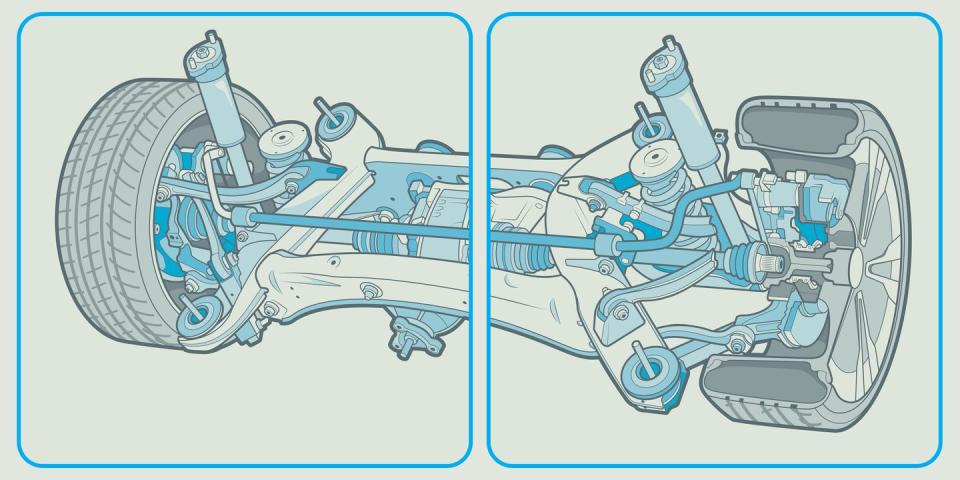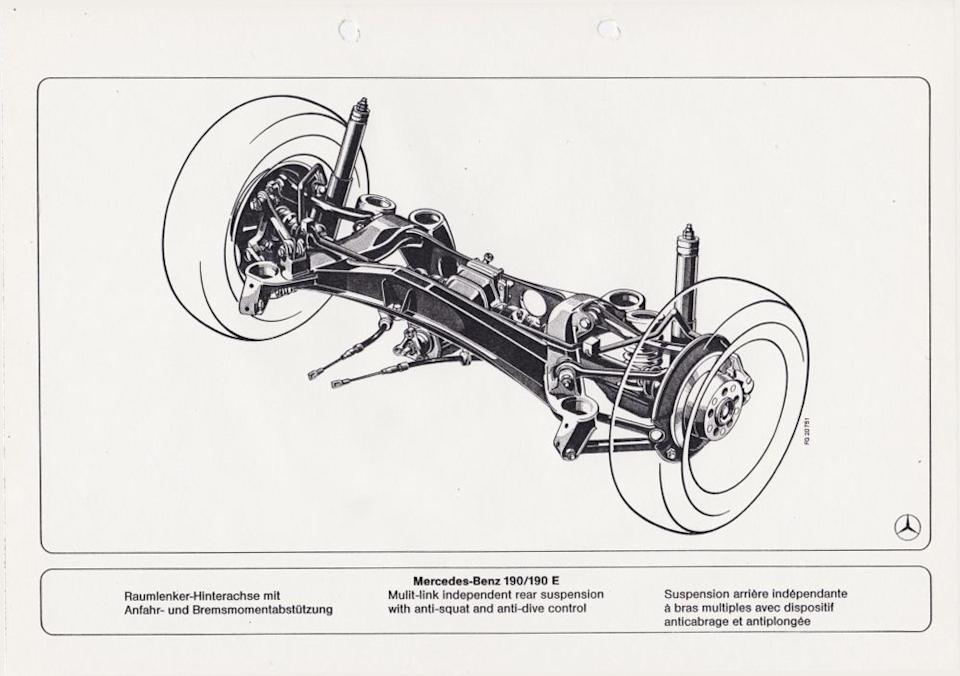Why Is Multi-Link Rear Suspension So Popular?

"Hearst Magazines and Yahoo may earn commission or revenue on some items through these links."
The design brief for the Mercedes-Benz 190 was simple: Build a Mercedes, only smaller. The W201, as it was known internally, was Mercedes-Benz's response to the oil crises of the Seventies and subsequent Corporate Average Fuel Economy (CAFE) standards in the company's largest export market, the United States.
This car was designed during a golden era for Mercedes, when development costs were seemingly of no object. By today's standards, the 190 seems like a fairly conventional sedan, yet when it launched in 1982, it was a revolution. Among its many innovations was its rear suspension. This was the first car with multi-link rear suspension, consisting of individual upper and lower control arms that resemble wishbones and a camber control arm. The setup was lightweight and compact, and helped give the 190 more grip than the contemporary BMW 3-Series—which used snap-oversteer-inducing semi-trailing arm rear suspension—while maintaining excellent ride quality.
In the forty-plus years since the 190 debuted, many cars have employed multi-link rear suspension. This is purely anecdotal, but as a web writer for years, I've written up so many new-car stories that feature a sentence like "a [INSERT-SUSPENSION-OF-CHOICE-HERE] front paired with a multi-link setup at the back," and that's true for my colleagues too. So the rear suspension of the 190 was a cipher, right? Yes and no. It was a fabulous design, conceptually similar to what Mercedes uses to this day, but there are a lot of different types of multi-link suspension.
Let's review the basics here. To reiterate what I wrote in my article on double-wishbone vs. MacPherson strut suspension, the job of any independent suspension is to control five directions of tire motion: bump/jounce, rebound/droop, lateral, longitudinal, and camber. Each motion type requires its own suspension link, but these "links" don't have to be discrete parts. For example, a wishbone is two links joined together to create one part, while in a MacPherson strut suspension, you have a virtual upper link created by the slider mechanism of the strut itself.

The term "multi-link suspension" can refer to a number of different suspension designs, all of which include at least three lateral links. While the classic Mercedes multi-link design consists of five discrete links, there are other multi-link setups that use a combination of upper or lower wishbones, plus three individual links. The C4 Corvette, which debuted a few months after the 190, had a multi-link rear axle, too, though this suspension consisted of two trailing arms, a toe arm, a camber link, and the half-shaft. Race Car Vehicle Dynamics, one of the best books on vehicle dynamics for far more than just race cars, also describes multi-link suspension using H-arms, essentially a wishbone with an integrated toe link. So multi-link is popular in large part because the term "multi-link" is vague. Yet that doesn't fully explain why so many automakers use suspension designs belonging to the larger multi-link family.
A double-wishbone suspension is simple in concept, and arguably, it's still the design of choice for performance cars. Yet the wishbones are tasked with dealing with both up-and-down and fore-and-aft motion. This makes it hard, though certainly not impossible, to separate out ride and handling characteristics. By separating suspension links, engineers are given more tuning freedom than with any other suspension type, more control of ride and handling individually.From a parts perspective, a multi-link suspension is more complex than double wishbones, but that’s it’s greatest asset. There are more things for engineers to tweak.

"The biggest advantage of a multi-link is that it gets rid of a lot of trade-offs," says Doug Milliken, who along with his late father William authored and compiled Race Car Vehicle Dynamics. Done right, multi-link suspension provides great lateral stiffness and great fore-and-aft compliance, including recession, where the wheel moves back in the arch when going over a bump, providing extra comfort. Toe characteristics are also very good, depending on where engineers place toe links, and the system doesn't have too much friction, because it mostly consists of pivots, and there's only one slider, the damper. Compared with a double-wishbone or short-long-arm suspension, there's more rubber bushings in a multi-link suspension, which allow engineers a greater degree of tuning freedom. Engineers also have more ability to add anti-dive and anti-squat geometries, helping maximize grip under braking and acceleration, respectively, further improving performance.
Then, there's packaging. Because not all the links have to be joined, it's easier to incorporate the components you need within the space allotted, and similar to double wishbones, a multi-link setup requires less height than a MacPherson strut. That makes it a good choice for today's crossovers and SUVs, where multi-link suspension would eat into cargo room. On the flipside, this is why the MacPherson strut front suspension is so popular. Most cars being front-engine, there isn't a lot of width under the hood for double wishbones or multi-links, though, some cars have split wishbones up front, technically a multi-link design. A very rare example of a true five-link front suspension is the new Mercedes-AMG SL, which has a true five-link suspension at both ends. It uses a unique platform to any other Mercedes car, and one imagines it was very expensive to design.

It's kind of a throwback. Mercedes spent a ton on the W201 program, and presumably, the rear suspension made up a huge chunk of that budget. The Stuttgart engineers had access to computers to help design the five-link rear, but they also used a rig that looks like a bizarro moonbuggy to test all sorts of different suspension concepts. According to James Taylor's Mercedes-Benz W201 (190): The Complete Story, Mercedes tried seven different rear suspension designs, including a De Dion setup and swing-axles similar to what was used on the W123 E-Class. Now, computer design makes it much easier to design a multi-link axle.
The cheapest cars on sale today—your Nissan Versas, your Kia Rios—use non-independent torsion beam rear suspension. But, the vast majority of new cars sold in America have IRS, and of those, so many are multi-link. For automakers, tuning freedom and packaging advantages of multi-link makes it a more appealing option than MacPherson struts, despite being more expensive. (This isn't to say you can't do great things with a rear strut suspension. The Porsche Boxster and Cayman have always used a MacPherson rear because it's easier to package with their wide, mid-mounted flat-sixes and because it allows more suspension components to be shared between front and rear, yet, they have exceptional handling. As a Boxster owner, however, I must admit bias.)
You could spend a lifetime dissecting the pros and cons of every different variant of multi-link suspension, but that's probably only useful for car engineers. The main takeaway here is that multi-link suspension in its many, many forms makes sense for so many different platforms, models, and design philosophies. It's easy to see why Mercedes-Benz went all out on the rear axle for the 190, and it benefitted more than just that car.
You Might Also Like

 Yahoo Movies
Yahoo Movies 